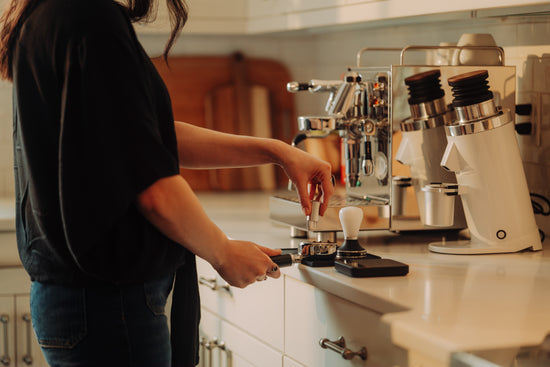Do You Really Need WDT?

In circa 2004-’05, when home espresso was just being born, a professor, espresso enthusiast, and visionary named John Weiss began tinkering with making his espresso shots pull and taste better. Weiss discovered, as we all take for granted now, that even grounds distribution leads to better extraction and, thus, tastier espresso shots. Ironically, WDT began with a single dissection needle he used in college; it was the closest tool nearby. This led to several DIY projects and espresso forum postings, including, but not limited to, modified wine corks with sewing needles or just a humble toothpick. Read more about the legend here and how much skepticism Weiss’s pioneering idea was met with, how it transformed, and where we are today. Now known as the Weiss Distribution Technique, let’s jump into the mechanics and theory of WDT.
What is WDT?
WDT is a simple way to break up clumps and evenly distribute the entire coffee bed of a portafilter basket. In practice, gently stirring the grounds in small circles will result in a more evenly distributed coffee bed and fluffier grounds—leading to more even extraction and fewer chances for channeling. Many home baristas report that using WDT with certain coffees increases extraction rates, clarity, and flavor. For those chasing consistency and the best-tasting espresso, WDT is a boon. WDT tools can come in many forms, from the primitive and cost-effective DIY wine cork & needle combo to stainless steel options with surgical grade needles like Clive’s LUCCA WDT tool and the SWORKS WDT tool.

Is WDT necessary for all grinders?
The short answer is, well, no. However, using WDT with any grinder will not negatively impact extraction. At Clive, we celebrate the spirit of less is more; we’d rather not have more steps for puck prep than needed. Don’t get us wrong, we love our coffee gadgets, but we also like getting into the business of drinking espresso more.
- High Performance—LUCCA Atom 75: Chosen for its large 75mm burrs. Generally, grinders with larger burrs do not necessarily need WDT for better distribution because the grounds the LUCCA Atom produces are fluffy and even.
- Mid Range—Eureka Mignon Zero: The Zero is a great mid-range choice because its 55mm burrs represent the average size of the majority of home espresso grinders and is designed for single-dosing.
- Budget—Fellow OPUS: The OPUS is interesting because it’s not exclusively an espresso grinder, so it doesn’t have the same range for espresso fine-tuning as the previous two choices; however, it’s still one of the most affordable home grinders that can grind fine enough for espresso.
WDT Test

We chose to run a simple test comparing shots without WDT and with WDT to see what impact WDT has on that specific grinder. For consistency, we decided to use a 1:1 ground coffee-to-liquid espresso ratio, the same espresso machine with each grinder (Profitec Pro 600), and the same coffee—a medium-to-dark espresso blend by The Great North. We chose the grinders based on their burr size and speculation if they would need WDT or not. We used a scale and a shot timer to ensure we hit our 1:1 ratio. We also used a PUQpress to ensure even and consistent tamping. Our espresso recipe is 20g ground espresso | 20g liquid yield | ~27 seconds.



While this test was limited to three grinders and one style of coffee, we found that WDT significantly shot consistency and wholly removed channeling in all of the shots we pulled across all three grinders. Adding WDT did not improve or hurt the shots pulled with the LUCCA Atom 75—they were already perfect without WDT, but it is nice to know that using WDT with 75mm burrs or above doesn’t have a negative effect. On the other hand, the two grinders with burrs 55mm and below (Zero & OPUS) benefited significantly from using WDT, leading us to conclude that, in general, WDT is most helpful in smaller home grinders and significantly reduced channeling and produced more even water flow through the puck. Another conclusion from the WDT test is how valuable 60mm and larger burrs can be for eliminating steps in your puck prep; starting with a higher-performing grinder in your espresso journey is something every aspiring home barista should consider.

If you have any questions about espresso technique or have product questions, don't hesitate to chat with us on our website, hop on a phone call with us at (888) 557-5320, email us at support@clivecoffee.com, or visit us at our Portland, Ore showroom between 10-5 Tuesday-Sunday. We’re looking forward to chatting espresso with you!